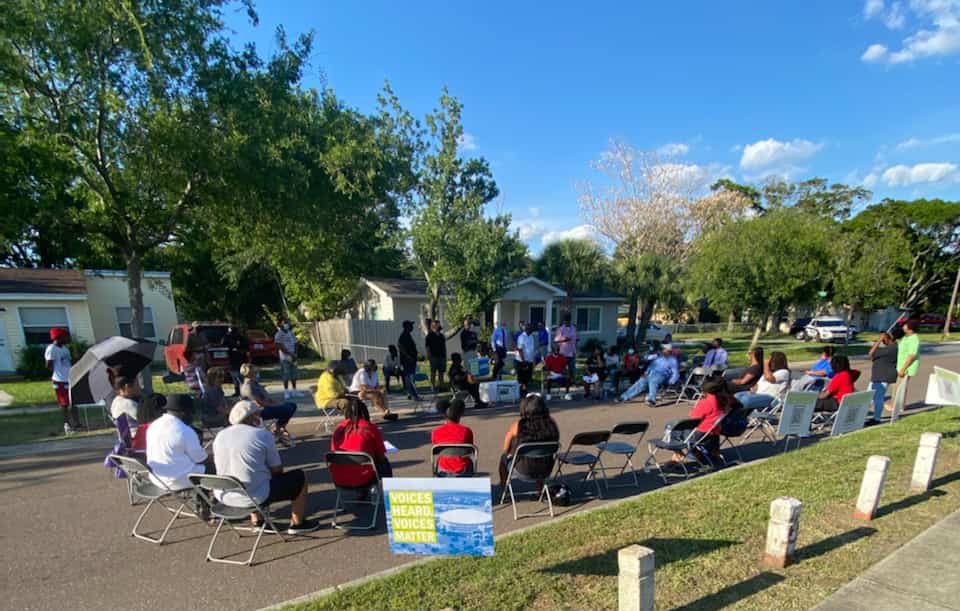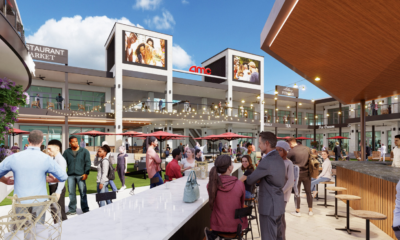Thrive
Neighborhood conversations could fuel a search for answers to troubling questions

The breeze was gentle under shady trees near the tennis courts at Lake Vista Park, a perfect setting for a late afternoon gathering of neighbors.
I sat at the edge of this circle of earnest residents, diverse in age, race and ethnicity and brought together by the NAACP St. Petersburg Branch. The moderated, yet plain-spoken discussion that day was one in a series of conversations whose theme was “We’re in this together, Our Communities Matter.”
The afternoon’s open-air assembly on folding chairs provided by city staff and lawn chairs brought from home touched on topics including safety, education, race and police reform. There were prayers, references to scripture and encouraging applause for those who braved the small crowd to say their piece.
It was also a time for catching up with old acquaintances and making new ones. A woman with a little girl introduced herself to me and mentioned she lives nearby. So do I, I said, pleased by the overture.
But the kumbaya moments that Friday disguised serious concerns. In recent months, some neighborhoods have been hit by gun violence. Families have been devastated and the community has sought explanations. Since the start of the year, there have been 15 homicides, 14 with guns. All suspects and victims have been Black.
Concern has led to the Enough is Enough campaign by City Council members Lisa Wheeler-Bowman and Deborah Figgs-Sanders, and the more recent NAACP neighborhood conversations to “air it all out.”
The first gathering to encourage “honest conversation on healing our community” took place in Childs Park. “Lend your voice and perspective as we seek greater understanding on how we stop the violence,” the notice on Facebook read.
When one of the sessions came to my neighborhood, I decided to attend – to listen.
One speaker lamented about the inadequacy of the education system. There was talk about encouraging some students to explore options other than college, such as technical and vocational schools. People spoke about the lack of role models, of children without father figures and about the responsibility to be a neighbor in an “it takes a village” sense.
Community leader Brother John Muhammad of Childs Park spoke of the need for self-knowledge. And in a bit of wisdom especially relevant today as some chafe against initiatives such as The 1619 Project, was this: “What we’ve been told about ourselves as Black people is not true.”
A woman in the circle of conversation spoke about being astonished at the area’s racism after having lived in cosmopolitan New York. She mentioned a man on Nextdoor who questioned the presence of a young Black man in a hoodie on his street. Another woman said she urged her husband not to go out for a walk wearing a mask. Simply, it’s not a safe thing for a Black man to do.
In the days following the Lake Vista Park gathering, I spoke with Esther Eugene, president of the local NAACP branch. The goal of the community conversations is “to provide solutions for the different things that are happening in the community,” she said.
“There has been a rash of gun violence. Neighbors might not know one another. It’s giving an opportunity to come out of their homes in a safe environment, in a circle of trust and to discuss things that truly are challenging. We need to feel safe in our neighborhoods. For the youth, they need to feel safe at school.”
She declined to discuss overall insights from the gatherings and said they probably will not be shared publicly. I was surprised, since I’d missed the Facebook post: “NO Press – this is a conversation amongst family because we ALL HAVE TO TAKE OWNERSHIP of each other !!!”
Nevertheless, Eugene did offer that there will probably be future community conversations. People have asked for more of them, she said.
I guess if another is held in my neighborhood, on public property, with the city as one of the partners – as it has been for the other gatherings – I’ll probably attend.
St. Petersburg Police Chief Anthony Holloway was among those who attended the first session. “It gave me the opportunity to hear from the community on what they think our next steps should be towards making the community safer,” he said in a statement.
Other leaders are also listening. I saw former Pinellas County Commissioner and St. Petersburg mayoral candidate Ken Welch at Lake Vista. City Council Member Gina Driscoll, whose district includes part of the city’s southern neighborhoods and who is running for reelection, was there as well.
I understand the NAACP’s desire to create an environment where residents can speak freely about their anxieties and needs – away from the eyes and ears of the media. I admit I’m biased, but I believe there are benefits to sharing experiences, however wrenching, with an often oblivious public.
Just this week, I saw an NBC news report about a New Jersey teacher who was making a valiant effort to connect with her missing students after her school instituted remote learning. As the camera showed her walking through an impoverished neighborhood, she spoke of some children not wanting to turn on their cameras because they didn’t want other students to see their homes. For someone whose concern about Zoom meetings centers on making sure the painting by my late mother-in-law is hanging just right in the background, that grabbed my attention.
The point is, there certainly is a segment of the population unashamed of displaying hate, of spewing judgment and blame. But I absolutely believe there’s a solid and growing group of people who are just the opposite.
An unsurprising presence at Lake Vista last Friday was the Rev. Andy Oliver of Allendale United Methodist Church, a congregation miles away on the other side of town. Known for his commitment to social justice, it seemed apt that he should give the closing blessing to the interracial, multicultural crowd gathered in peace to talk, listen and support their neighbors.








Tom
May 7, 2021at4:37 pm
To say that there are 15 homicides in the city and all of the victims are black may be factually correct but not the complete story. Most black people in Pinellas County live in safe well-kept and very desirable neighborhoods.
If you mark on a map the places where victims lived and where they died you will see the concentration of violence is in a small part of the city going from Childs Park on the west to Martin Luther King Street on the east and from 5th Avenue to about 18th Avenue South.
Decades of violence have left residents traumatized and afraid to call police to report gunshots and other crime that they witness.
Bartlett Park was once a major crack cocaine drug hole that led the city in homicides but has been relatively free of gunfire and killings since 2009. What worked here to save lives could work in other parts of South St Pete.